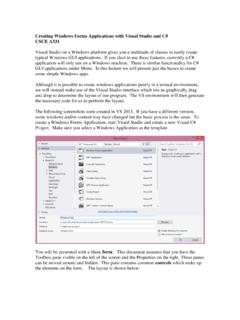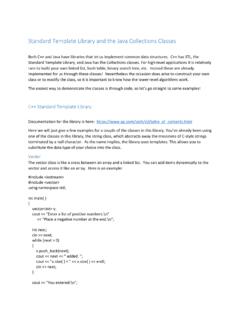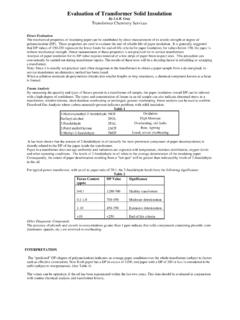Transcription of Random Number Generation C++
1 Random Number Generation C++. It is often useful to generate Random numbers to produce simulations or games (or homework problems :) One way to generate these numbers in C++ is to use the function rand(). Rand is defined as: #include <cstdlib>. int rand();. The rand function takes no arguments and returns an integer that is a pseudo- Random Number between 0 and RAND_MAX. On transformer, RAND_MAX is 2147483647. What is a pseudo- Random Number ? It is a Number that is not truly Random , but appears Random . That is, every Number between 0 and RAND_MAX has an equal chance (or probability) of being chosen each time rand() is called.
2 (In reality, this is not the case, but it is close). For example, the following program might print out: cout <<rand() << endl;. cout <<rand() << endl;. cout <<rand() << endl;. 1804289383. 846930886. 1681692777. Here we randomly were given numbers between 0 and RAND_MAX. What if we only wanted numbers between 1 and 10? We will need to scale the results. To do this we can use the modulus (%) operator. Any integer modulus 10 will produce a Number from 0-9. In other words, if we divide a Number by 10, the remainder has to be from 0 to 9.
3 It's impossible to divide a Number by 10 and end up with a remainder bigger than or equal to ten. In our case: 1804289383% 10 = 3. 846930886% 10 = 6. 1681692777% 10 = 7. Consequently, we can take rand() % 10 to give us numbers from 0-9. If we want numbers from 1-10 we can now just scale up by adding one. The final result is: cout << (rand() % 10) + 1 << endl;. If you run this program many times, you'll quickly notice that you end up with the same sequence of Random numbers each time. This is because these numbers are not truly Random , but pseudorandom.
4 Repeat calls to rand merely return numbers from some sequence of numbers that appears to be Random . Each time we call rand, we get the next Number in the sequence. If we want to get a different sequence of numbers for each execution, we need to go through a process of randomizing. Randomizing is seeding the Random Number sequence, so we start in a different place. The function that does this is srand() which takes an integer as the seed: void srand(int seed);. It is important to only invoke the srand call ONCE at the beginning of the program.
5 There is no need for repeat calls to seed the Random Number generator (in fact, it will make your Number less evenly distributed). A commonly used technique is to seed the Random Number generator using the clock. The time(). function will return the computer's time. On transformer, this is expressed in terms of the Number of seconds that have elapsed since Jan 1, 1970 (the Epoch). The function time(NULL) will return the Number of seconds elapsed in computer time. #include <ctime>. srand(time(NULL)).
6 Cout << (rand() %10) + 1;. This produces different values each time the program is run. Call By Value C++ and Java Both Java and C++ invoke functions using a mechanism called Call By Value . If we pass a variable to a function then the function gets the value contained in the variable. However, any changes that are made to the variable in the function are not reflected back in the calling program. These parameters are considered local variables. To illustrate, consider the following: void ChangeValues(int x); // Prototype int main().
7 {. int x=5;. ChangeValues(x);. cout << Back in main: << x << endl;. return 0;. }. void ChangeValues(int x). {. cout << In change values: << x << endl;. x = 10;. cout << In change values: << x << endl;. return;. }. When this program is run, we get: In change values: 5. In change values: 10. Back in main: 5. Note that inside the function ChangeValues, we initially get x=5, or the value that was assigned in main to x. Then x is changed to 10, and the new change is reflected in the print statement. However, when we return back to the main function, x is unchanged and is back to 5.
8 The parameter x inside ChangeValues is referred to as a local variable, because changes to it are only enforced within the scope of the function. We'll have more to say about scoping later. Note that we can still have functions that use pass by value, but return a value: int ChangeValues(int x); // Prototype int main(). {. int x=5, y=0;. y=ChangeValues(x);. cout << Back in main x= << x << y= << y << endl;. return 0;. }. int ChangeValues(int x). {. int y;. y = 20;. x = 10;. return 10;. }. This will output: Back in main, x=5 y=10.
9 Or we returned a value of 10 which is reflected in main. The variable y' defined in ChangeValues is also a local variable, and only exists within the scope of the ChangeValues function. Back in main, we are referencing main's variable y, not the y defined in ChangeValues. Underneath the Hood The Stack and Parameter Passing What is happening when we call functions and pass parameters back and forth? It is very useful to know how this is done architecturally in the computer. Local variables and parameters are passed using the stack in the computer.
10 The Stack You can visualize the stack like a stack of trays in a cafeteria. A person grabs a tray from the top of the stack. Clean trays are also added to the top of the stack. In general operation, you never touch anything that is not on top of the stack. This has the property of LIFO Last In, First Out. The last thing you put into the stack is the first thing that will be taken out. In contrast, the first thing put into the stack is the last thing that is taken out. The computer implements the stack using a chunk of memory, with a special register named the stack pointer that remembers the place in memory that contains the top of the stack.












